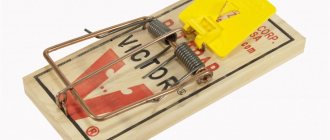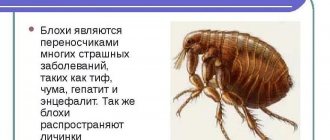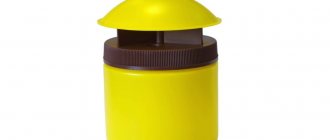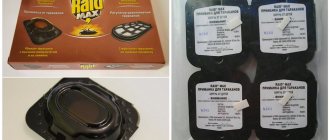DIY flea traps
Flea trap with floating candles
Destruction of parasites in the apartment
Flea traps are effective only against adult fleas and help reduce the number of parasites. Used in conjunction with other flea products or when the use of other methods is not allowed.
Lamp
Parasites intensify their activity with the onset of darkness, but are attracted by bright light. The lamp trap is made very quickly and is quite effective. By using it several nights in a row, you can get rid of an entire colony of parasites.
On a note!
A table lamp-night light is best suited for these purposes. Place on the floor. A plate filled with soapy water is placed under it. Add dishwashing detergent. It creates a light film on the surface of the water, which promotes the adhesion of insect legs.
The light attracts fleas, they jump onto the white plate and immediately drown. A simple trap for fleas in the apartment absolutely free. Can be used an unlimited number of times.
DIY flea traps
Is it possible to catch fleas without light?
The active period of insects is the dark time of day, so traps set at night attract more insects. It is better for neither humans nor pets to stay in a room with flea repellent, otherwise the attractiveness of the bait will decrease.
To make such a flea trap with your own hands, you will need a container of water and dishwashing liquid. The detergent is dissolved in water to create an environment from which bloodsuckers cannot escape. The resulting mixture is placed near the area of mass destruction by insects and left overnight. In the morning, the liquid is poured out and the container is washed.
Water with any parasites must be poured into the toilet, otherwise the surviving insects will crawl back out of the sink.
Thanks to the dishwashing detergent, the water loses its surface tension, the parasites do not stay on it and go to the bottom. And when creating soap foam, the opportunity to get out of the trap is practically lost.
Floating candles
Flea trap with floating candles
You will need several special floating candles. Fill a plate or shallow bowl with soapy water. They lower the candles and light them. Place the trap on the floor overnight.
Unlike the previous option, these candles burn longer and additionally attract the attention of fleas with movement. They emit more light and heat. Insects stick to the wax or drown in the water. The wider the container in diameter, the greater the number of parasites that will be caught.
On a note!
If the room is heavily infested, a flea trap with floating candles is placed in several corners of the room. In the morning, all you have to do is throw away the contents, and in the evening prepare a new combination of candles.
Table lamp flea trap
Insects are thermophilic and flock to the light in the blink of an eye. They live by reflexes. Attracts the warmth emanating from the body of a living creature and more. There is no need to construct a flea trap. All components are available in the household. For the trap you will need:
- table lamp or lamp;
- plate;
- water;
- dishwashing liquid.
Since fleas are active in the dark, the flea trap is placed in the evening. Pour water into a plate to fill ¼ of the container. Dishwashing detergent is added on the principle that it is better to add too much than not to add. The insect swims very well in water and even crawls out from the bottom of the vessel. The product will make the water viscous. Then the parasites will not float on the surface, but drown. Stir gently, but do not foam.
In a dark room, turn on the lamp and point the lamp at the plate with the prepared product. The flea trap is ready. Insects will jump to the bright light and heat emitted from the bulb. They will begin to fall en masse into a bowl of water. All that remains is to remove the trap in a few hours. Because the lamp's operation is limited. To avoid overheating, take a break. Then you can repeat the procedure again.
Honey
Acts like duct tape. Honey is applied in a fairly thick layer to a thick sheet of cardboard. Place it on the floor in the room where there are the most fleas, and additionally illuminate it with a lamp. Insects will react to light and stick to honey.
The advantage of this method of catching pests is its simplicity. But when compared in terms of efficiency, traps made from soapy water are in no way inferior. The question arises whether it is worth spoiling such expensive honey for fleas. A ready-made sticky tape trap will work in a similar way.
TV flea trap
Anyone who has encountered a flea infestation in a room is familiar with the situation when, when the TV is turned on, fleas begin to become intensely active. They even jump on the screen. Why not use this to your advantage. Turn on any TV show and place a container of water near the screen. In this case, it is better to use a baking sheet, a form for baking cake layers. Detergent is also added to the water. Turn off the sound and go to bed quietly. The fleas will go on a real spree. And by morning it will become clear how many participants there were in all this. By repeating the procedure with the trap for several days in a row, you can get rid of an entire population of parasites in the apartment. Moreover, without much effort. Interestingly, fleas react better to the light of a TV than to a light bulb or candle. The TV flea trap is one of the most effective.
TV
A DIY flea trap using a TV is suitable for those who don’t turn it off at night. Insects react extremely actively to the light of this device, even better than to candles or a lamp.
The sound is turned off, a baking tray filled with soapy water is placed under the TV. Liquid with added dishwashing detergent will shimmer under the glow of light. The attention of pests will be attracted to movement from the constantly changing image.
Then everything works according to a familiar scenario. Fleas jump into the light, fall into the water, and drown. In terms of efficiency, this is the best DIY trap. In a few nights you can catch a whole horde of pests.
Types of flea traps
According to the principle of operation, flea traps are conventionally divided into water and glue. The water trap is a flat bowl filled with warm, soapy water, and the glue trap is a sheet of paper or cardboard with one sticky side. Since fleas move on the floor, traps are placed on the floor accordingly.
Dishwashing detergent or liquid soap is added to the water trap to neutralize the surface tension of the water, which holds small insects to the surface. In clean water, fleas do not drown because their weight is too small.
If attractants (or baits) are not used, fleas will fall into such a trap by accident, and the effect will be weak.
By nature, fleas are able to detect nearby heat sources that signal where to look for a host. In the dark, fleas, like other insects, are attracted to light. These two instincts are effectively used to lure parasites into a trap.
Lamp flea trap
The warmth and light of the lamp attracts insects like a magnet. If you place a lamp over a water trap, fleas jumping into the light will fall into the soapy water and drown. This is the most popular and effective flea trap and is easy to assemble.
Candle trap
The light of a burning candle has a similar effect on fleas. Placing a candle in the middle of a tank of water or placing a floating tea light on the surface will not create a fire hazard. The light from a candle is softer and does not hurt your eyes at night, and traps can be placed simultaneously in different corners of the room.
TV trap
Those who do not turn off the TV at night can use it as a bait for fleas. In the dark, the TV attracts insects with the light and heat it emits. All that remains is to place a container or baking tray with soapy water in front of it or lay out sheets of sticky paper.
Glue trap with light
A lamp can lure fleas both into water and into a glue-based trap. Resourceful entrepreneurs have established commercial production of such flea catching devices and sell them through online stores. But you don’t have to spend money on a purchase; you can make such simple devices yourself. Just lay out sheets of sticky paper under the lamp and leave it overnight. Some people use pieces of cardboard smeared with honey instead of sticky paper.
Houseplant trap
Another attractant for blood-sucking parasites is carbon dioxide, which fleas also use to navigate when searching for victims. As you know, plants emit carbon dioxide in the dark. If you place the plant on the floor next to a water or glue trap, fleas will be caught even without the use of lamps and candles. But the luring effect of heat and light is stronger.
Carpet
With the help of such a trap, you get rid of not only fleas, but also larvae, even eggs. The option is best suited if fleas have settled on the floor under the carpet.
Destruction of parasites in the apartment
The procedure is recommended to be carried out in the evening.
- First, you should vacuum the carpet.
- Mix washing powder or baking soda with boric acid.
- Thoroughly rub the mixture into the carpet, remembering to use rubber gloves to protect your hands.
- Leave until morning. The next day, the destruction of parasites continues. Vacuum several times, throw the contents of the bag outside or flush it down the toilet.
Traps for controlling fleas from water
Cups, cups, and plates are used as containers. Fill halfway with water. Add any detergent for effectiveness. Some even use bleach. Place a flea trap on windowsills on sunny days. Despite the fact that parasites are nocturnal, they also make themselves felt during the day. Especially if the premises are heavily infested. In any case, such flea traps will be useful. Moreover, they are prepared quickly and easily. The insect is capable of jumping to a height of up to 1.5 meters. Therefore, they can easily climb onto the windowsill. Water in a transparent trap container will attract insects by overflowing.
How do flea traps work?
The principle of operation of homemade devices is no different from how systems for catching insects, rodents and even some animals are designed. To catch as many fleas as possible, you must first lure them, not allow them to jump away, and then destroy them.
All flea traps, which are made at home according to the schemes described below, lure parasites using:
- dampness;
- high temperature;
- bright lighting;
- Sahara;
- household chemicals, detergents.
Fleas are not indifferent to all of the above. Moreover, a combination of several factors can make the invention even better. The design and principle of operation of each trap is selected individually, taking into account the nuances of the room.
The benefits of using home inventions include:
- safe exposure to people and pets;
- enhanced action in combination with other means to combat parasites.
What attracts fleas?
Contents hide
Fleas are more than just annoying insects. They pose a real threat to both your health and the health of your pets. You can fight them as much as you like by pouring heaps of chemicals on the animals. But the effect seems to be zero: just as the dog was itching, it still itches. Where do fleas come from? How do they live, what attracts them? Depending on their life stage, fleas need food, warmth, darkness, movement and exhaled air to survive.
Fleas are far from harmless creatures. They cause not only discomfort to our little brothers. From their constant bites, animals develop severe skin irritation - as a rule, they suffer from an allergy to saliva. Flea dermatitis, one of the most common allergic diseases, develops.
Fleas are also carriers of bubonic plague and typhus. Fleas often cause people and their pets to become infected with tapeworms and ticks. In turn, mites cause scab, scabies, itchy skin and dermatitis. Due to decreased levels of red blood cells in the blood, your pets may develop anemia.
Warm. Fleas are heat-loving creatures, they need a temperature of at least 18.5 ̊ C. That’s why they get as deep as possible into the fur of pets, closer to the skin. So one should not naively hope for the arrival of winter and winter frosts. Among other things, fleas are concerned about their survival. Insects that settled on your dog in the summer will begin to look for winter quarters with the onset of cold weather - that is, carpets, floorboards, etc.
Life cycle. The female flea lays up to 50 eggs per day (!) in the fur of host animals. The eggs, however, do not stay there for long; they fall onto carpets, furniture, cracks in the floor, in a word, into various dark corners. The darker the better. A little time passes, and larvae emerge from the eggs. They feed mainly on undigested feces of adult fleas. The larvae then acquire a silk-like cocoon and pupate. The development of the pupa takes only 10 days. That's all - the result is an adult flea, which immediately begins an active search for the owner. An adult flea lives on average from a couple of months to a year.
Carbon dioxide and movement. Yesterday's sleeping pupae come to life, barely sensing body heat, movement and the exhaled air of a potential owner (it is filled with carbon dioxide). Attracted by yellow-green light or contrasting shadows on a light background, freshly grown adult fleas jump up to the level of the future owner's leg, almost immediately starting to eat. If an adult flea does not eat immediately, it will die.
Control fleas on your pets. We hope that reading our material awakened some emotions in our readers. As we see, it is impossible to put up with the presence of fleas on your furry friends. Thank God, scientific and technological progress does not stand still; effective drugs have appeared on sale that allow you to completely get rid of these insects. Still, we would not recommend prescribing treatment on your own. It is better to consult with your veterinarian, who will offer the latest and most effective medications. What can you do? Carefully wash and rewash all things your pet uses in hot soapy water (including mattresses, toys, etc.). Wet clean your house using hygiene products as often as possible (be sure to look into every crevice). Vacuum your house or apartment two to three times a week (at least). Treat furniture. If you are absolutely sure that there are fleas in the house, dispose of the vacuum cleaner bag after cleaning.
In addition to chemicals, folk remedies have also worked well: herbal mixtures, garlic, brewer's yeast, pine shavings, baking soda, table salt, citrus peels.
Original : What Attracts Fleas? Posted by Tammy Quinn Mckillip. Source : cuteness.com Photo : pixabay.com











